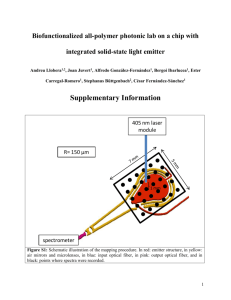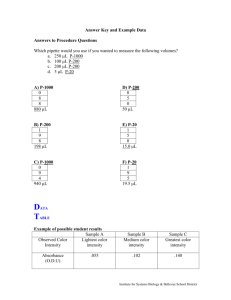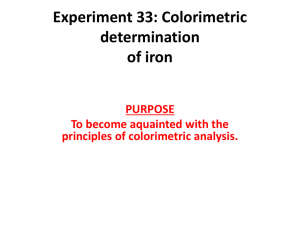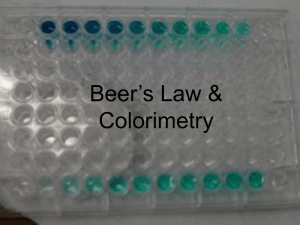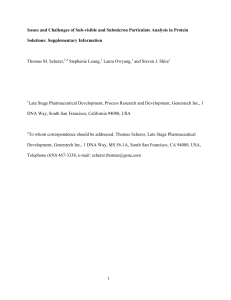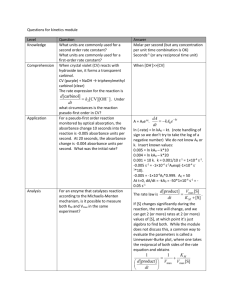S3 Fig. - Figshare
advertisement
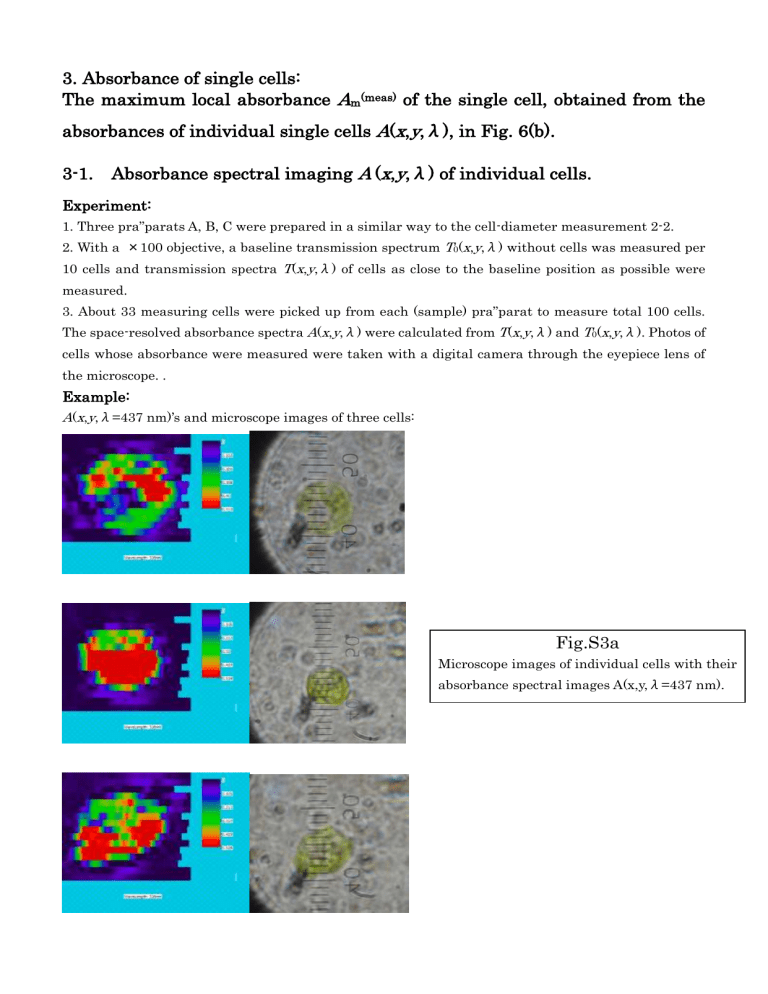
3. Absorbance of single cells: The maximum local absorbance Am(meas) of the single cell, obtained from the absorbances of individual single cells A(x,y,λ), in Fig. 6(b). 3-1. Absorbance spectral imaging A (x,y,λ) of individual cells. Experiment: 1. Three pra”parats A, B, C were prepared in a similar way to the cell-diameter measurement 2-2. 2. With a ×100 objective, a baseline transmission spectrum T0(x,y,λ) without cells was measured per 10 cells and transmission spectra T(x,y,λ) of cells as close to the baseline position as possible were measured. 3. About 33 measuring cells were picked up from each (sample) pra”parat to measure total 100 cells. The space-resolved absorbance spectra A(x,y,λ) were calculated from T(x,y,λ) and T0(x,y,λ). Photos of cells whose absorbance were measured were taken with a digital camera through the eyepiece lens of the microscope. . Example: A(x,y,λ=437 nm)’s and microscope images of three cells: Fig.S3a Microscope images of individual cells with their absorbance spectral images A(x,y,λ=437 nm). 3-2 . The average cell-diameter da of the individual cells in the single absorbance measurement. Analysis: The photos of the 100 cells magnified by ×100 taken in 3-1 were analyzed with the open software ImageJ to obtain the cell diameter. If the shape of a cell is an ellipse, the diameter d was calculated as d=√major axis×√minor axis. Result: As a result, the average diameter was da=7.057±1.407 μm. Similarly to the diameter analysis for the cell suspension, the diameter distribution was converted to the volume distribution to obtain the average effective diameter, da=7.327±1.506 μm. (The average da was not directly used in the text. The distribution of d in 100 cells shows a good measure to judge whether a typical group of cells are sampled from the suspension. ) 3-3. The average absorption coefficient α and the maximum local absorbance Am(meas) in Fig. 6(b) of the single cell, from measurement of single-cell absorbance. Analysis: 1. The average absorbance Asphere of the cell was evaluated from the local absorbance of the cell with the method in Appendix 2[2], where the maximum local absorbance Am of the cell is given by 3 Asphere /2. The shape of the chloroplast was assumed to be spherical or elliptical, so that the whole local absorbances were summed up within the individual chloroplast diameter d estimated in 3-2 even if a transparent region was included there. In other words, a minimum circle or ellipse, which encloses any spot where absorbance at 437 nm is finite (chlorophyll a B-band), was taken as the shape. 2. As a result, the absorption coefficient i of the i th cell with d i was estimated from Am (i ) by i Am ( i ) ln 10 / di . Then, the average α of the cell was estimated by d d i i 3 i i local absorbance Am(meas) of the single cell was finally obtained by 3 i Am(meas)=αds/ln10. . The maximum Result: α(437 nm)=0.185±0.051 µm was obtained with the distribution shown in the graph below. 20 (437nm)=0.185±0.051m Gaussian 0.6 Absorbance 15 10 0.4 0.2 5 0.0 0 0.0 0.1 0.2 0.3 absorption coefficient(λ=437nm)[μm 0.4 -1 400 500 600 Fig.S3c Single-cell absorbance averaged for 100 cells. Distribution of α for 100 cells. The spectrum is shifted by -0.0116 to show zero absorbance at 750 nm. 0.8 Single-cell absorbance Am(meas)(measured) Single-cell absorbance Am(calc) (calculated from the cell suspension abs.) 0.6 0.4 0.2 0.0 400 500 700 Wavelength[nm] ] Fig.S3b Absorbance Frequency 0.8 -1 Maximum local single-cell absorbance Am(meas) 600 700 Wavelength[nm] Fig.S3d Comparison between single-cell absorbance calculated from cell suspension absorbance and that averaged over 100 single-cell measurements, the same as in Fig. 6(b).
